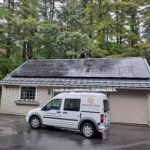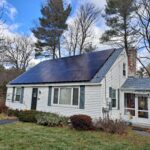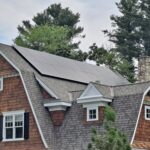Yesterday marked the official start of winter. That means snowy weather in Massachusetts is imminent – actually as I look out my window, I can assure you that it’s here. If you’ve invested in solar power, you want to make certain your photovoltaic (PV) system will continue to produce power throughout the cold season. In New England, other than the shorter days, the biggest hindrance to solar energy production in the winter is snow. I’m going to tell you a few ways to keep the snow off of your investment.
First off, I don’t think it is necessary to clean your solar panels after every single snowfall, or any snowfall for that matter. The roof of most homes is not easily accessible and it is not worth putting yourself in a dangerous situation to clean off the panels. If your roof is easy to get to and you have the time and energy to clean your panels, then clearing the snow will help with solar energy generation, especially after a good storm.
Your best options to remove snow from solar panels include:
- Wait it out. Your home’s roof is most likely pitched. The steeper the pitch, the quicker the snow will run off. Your solar panels are made of a slippery glass. When a corner of the panel is exposed, it heats up the rest of the module and snow will easily slide away. In the case of heavy accumulation, this could take more than one day to melt.
- Hose it down. A lot of homeowners choose to spray their array down with a pressurized hose. This may quickly take care of snow accumulation, but be aware that this may backfire if temperatures are below freezing. I wouldn’t recommend replacing a sheet of snow with a sheet of ice.
- Rock salt, RainX, or car wax. No thanks. I have heard of people using rock salt to melt snow from solar panels, but I don’t think this is a smart move. Salt can cause damage to your roof shingles and stain your siding. I’ve never tried RainX or car wax, but I wouldn’t suggest either. Your solar panels have a warranty and using a foreign substance on them may void that agreement. The risk just isn’t worth the reward.
- Play some football. I’ve seen some discussion forums mention using a nerf football to shed snow from your roof. The logic is once you have the smallest portion of the panel exposed, it will heat up the rest of the module and the snow will skim off.
- Retrofit a roof rake. You can find a roof rake at most hardware and department stores in New England for about $50 It typically has an aluminum blade use to remove snow from the roof and prevent ice dams. The conventional roof rake can damage to roof shingles and solar panels so it is important you add a squeegee type device to the blade to protect your equipment.
- Buy a telescoping soft roof rake. Roofrake.com sells a 24 Foot Telescoping Extra Soft Snow Pro for $65. Its telescoping capabilities allow you to reach areas of your roof from the ground and its durable foam head ensures that your PV panels will be free of damage.
I would love to hear other ways people are making sure their solar array is clear of snow so please include any other suggestions. If you’re interested in solar panels for your home or business in Massachusetts, Brightstar Solar offers a complimentary solar evaluation and free estimate. During our appointment, we would be happy to answer any questions you have about the installation or associated maintenance required.








Pingback: How to Remove Snow from Solar Panels — BRIGHTSTAR SOLAR
Pingback: Tweets that mention How to Remove Snow from Solar Panels — BRIGHTSTAR SOLAR -- Topsy.com
A swiss company Volotek just came out with a self cleaning solar panel but it’s not on the market yet and of course it’s too late if you already have your panels.
http://www.volotek.com/renewable-technologies
I needed more than 24 feet to reach the solar panels. Called the folks at http://www.roofrake.com and they sent me a system that could reach 35 feet with the same soft roofrake head you use on the telescoping poles. I push and pull a couple of feet of snow off each panel (maybe it’s the way it’s strung) but with a little cleared off each they start to heat up a bit and the rest isn’t so much work.
Great advice, Cathy! Thanks for sharing!
Pingback: Will the Sun Stop Producing Solar Power? — BRIGHTSTAR SOLAR
TO WHOM IT MAY CONCERN,
I was wondering if you know of where one could get a telescoping pole for removing snow from the roof top. Do you happen to make poles around 35ft.
P.S. Thank You for any help that you may give in return.
Sincerely,
Mike Schwingel
mschwi_2000@hotmail.com
I would contact the guys at roofrake.com. They have an assortment of telescoping poles and should be able to help you with what you’re looking for.
We have used ice melt socks since 2001 to keep snow and ice off our solar cells. The only time we need to refill them is if it rains for a few hours. Usually not a problem in Northern Illinois.
we have solar panels on our garage roof, currently covered with 1-2 ft of snow. my plan is to climb to peak of roof from back side (not covered with panels and with considerably less snow) to position a rope under snow but above panels. the rope will be long enough to extend beyond either end of roof peak and hang down to ground, plus several extra feet on either side. then, with one person at either end of rope to ‘saw’ back and forth through snow until it avalanches or cuts through snow at bottom edge… any comments or suggestions? thx.
Use a garden sprayer filled with car windshield de-icer fluid.
We’re debating among snow guards (most expensive, longest wait to resume production, least work), a roof rake (the other extreme on all three counts), or possibly installing some kind of little roofed porch over our front door and allowing everything to slide off by itself. This would be also be least work but a medium expense and a medium wait to resume production, since we’d be letting the snow avalanche on its own. We’re concerned about production but mostly about safety over the entranceway, and we have no idea whether a little porch, with roof slanted to the sides, would deflect the avalanche to the sides of the entrance or whether the momentum of an avalanche would just coast right over and end up in the entrance pathway anyway. Any insights?
Your point of view caught my eye and was very interesting. Thanks. I have a question for you.
I don’t think the title of your article matches the content lol. Just kidding, mainly because I had some doubts after reading the article.
Your article helped me a lot, is there any more related content? Thanks!
Your point of view caught my eye and was very interesting. Thanks. I have a question for you.
услуги по продаже аккаунтов продажа аккаунтов
заработок на аккаунтах https://marketplace-akkauntov-top.ru/
маркетплейс аккаунтов соцсетей безопасная сделка аккаунтов
перепродажа аккаунтов маркетплейс аккаунтов
купить аккаунт https://prodat-akkaunt-online.ru/
перепродажа аккаунтов магазин аккаунтов социальных сетей
купить аккаунт продать аккаунт
Website for Buying Accounts Account Buying Service
Online Account Store Account Trading Service
площадка для продажи аккаунтов https://akkaunt-magazin.online
продажа аккаунтов https://akkaunty-optom.live
продажа аккаунтов online-akkaunty-magazin.xyz
продажа аккаунтов akkaunty-dlya-prodazhi.pro
маркетплейс аккаунтов соцсетей kupit-akkaunt.online
cheap facebook accounts buy-adsaccounts.work
buy facebook advertising https://buy-ad-accounts.click
buy aged facebook ads account https://buy-ad-account.top
facebook ad accounts for sale https://buy-ads-account.click